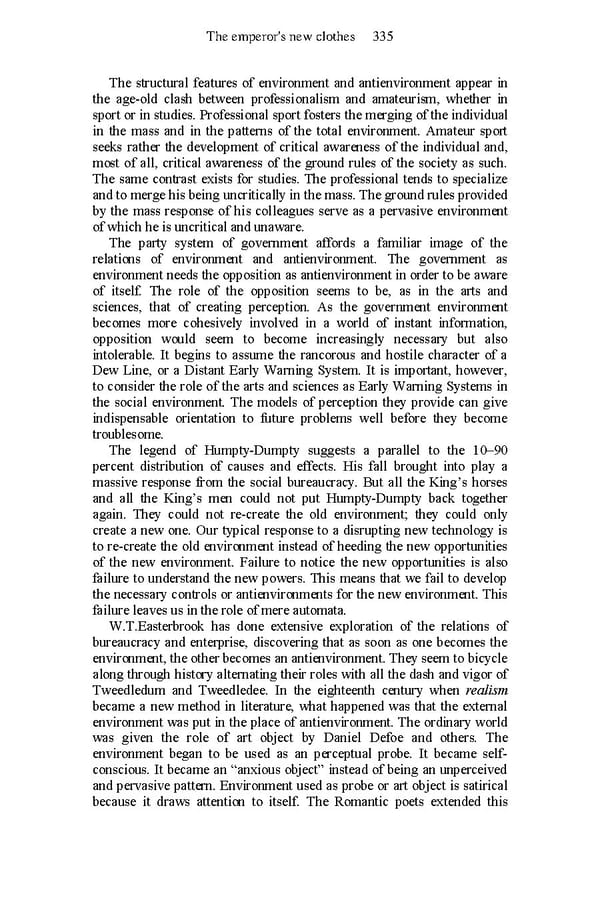The emperor's new clothes 335 The structural features of environment and antienvironment appear in the age-old clash between professionalism and amateurism, whether in sport or in studies. Professional sport fosters the merging of the individual in the mass and in the patterns of the total environment. Amateur sport seeks rather the development of critical awareness of the individual and, most of all, critical awareness of the ground rules of the society as such. The same contrast exists for studies. The professional tends to specialize and to merge his being uncritically in the mass. The ground rules provided by the mass response of his colleagues serve as a pervasive environment of which he is uncritical and unaware. The party system of government affords a familiar image of the relations of environment and antienvironment. The government as environment needs the opposition as antienvironment in order to be aware of itself. The role of the opposition seems to be, as in the arts and sciences, that of creating perception. As the government environment becomes more cohesively involved in a world of instant information, opposition would seem to become increasingly necessary but also intolerable. It begins to assume the rancorous and hostile character of a Dew Line, or a Distant Early Warning System. It is important, however, to consider the role of the arts and sciences as Early Warning Systems in the social environment. The models of perception they provide can give indispensable orientation to future problems well before they become troublesome. The legend of Humpty-Dumpty suggests a parallel to the 10–90 percent distribution of causes and effects. His fall brought into play a massive response from the social bureaucracy. But all the King’s horses and all the King’s men could not put Humpty-Dumpty back together again. They could not re-create the old environment; they could only create a new one. Our typical response to a disrupting new technology is to re-create the old environment instead of heeding the new opportunities of the new environment. Failure to notice the new opportunities is also failure to understand the new powers. This means that we fail to develop the necessary controls or antienvironments for the new environment. This failure leaves us in the role of mere automata. W.T.Easterbrook has done extensive exploration of the relations of bureaucracy and enterprise, discovering that as soon as one becomes the environment, the other becomes an antienvironment. They seem to bicycle along through history alternating their roles with all the dash and vigor of Tweedledum and Tweedledee. In the eighteenth century when realism became a new method in literature, what happened was that the external environment was put in the place of antienvironment. The ordinary world was given the role of art object by Daniel Defoe and others. The environment began to be used as an perceptual probe. It became self- conscious. It became an “anxious object” instead of being an unperceived and pervasive pattern. Environment used as probe or art object is satirical because it draws attention to itself. The Romantic poets extended this
 Essential McLuhan Page 341 Page 343
Essential McLuhan Page 341 Page 343